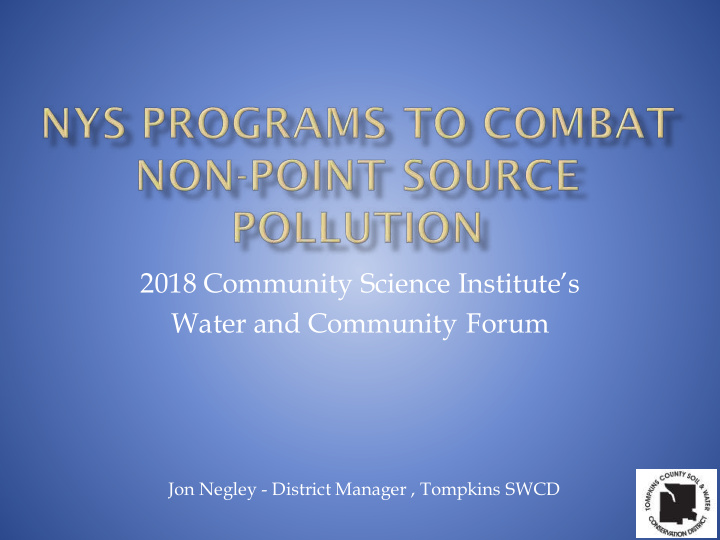



2018 Community Science Institute’s Water and Community Forum Jon Negley - District Manager , Tompkins SWCD
A CHALLENGING POINT SOURCE! The term "nonpoint source" is defined to mean any source of water pollution that does not meet the legal definition of "point source" in section 502(14) of the Clean Water Act. The term "point source" means any discernible, confined and discrete conveyance, including but not limited to any pipe, ditch, channel, tunnel, conduit, well, discrete fissure, container, rolling stock, concentrated animal feeding operation, or vessel or other floating craft, from which pollutants are or may be discharged. This term does not include agricultural storm water discharges and return flows from irrigated agriculture. ?
Nonpoint source pollution generally results from land runoff, precipitation, atmospheric deposition, drainage, seepage or hydrologic modification. Nonpoint source (NPS) pollution, unlike pollution from industrial and sewage treatment plants, comes from many diffuse sources. NPS pollution is caused by rainfall or snowmelt moving over and through the ground. As the runoff moves, it picks up and carries away natural and human-made pollutants, finally depositing them into lakes, rivers, wetlands, coastal waters and ground waters
Photo Credit: Bill Hecht
“Don't tell me what you value, show me your budget, and I'll tell you what you value.” -Joe Biden
$300 Million allocated for the EPF in FY18-19 • NYS Budget Second year in a row that the EPF has been • fully funded Many of the programs in NYS used to address • NPS pollution originate funds out of the EPF
Agricultural NPS Pollution Control ($17 Million) • Water Quality Improvement Program ($20.25 • Million) Finger Lakes/Lake Ontario Watershed Protection • Alliance FLLOWPA ($2.3 Million) Soil and Water Conservation Districts ($10 Million) • Waterfront Revitalization ($14 Million) • Solid Waste Program ($38.174 Million) • Climate Change Mitigation and Adaptation • Program ($19.15 Million)
A gricultural E nvironmental M anagement 5 Tiers - Inventory Questionnaire ▪ Tier 1 - Assessment Worksheets ▪ Tier 2 - Planning ▪ Tier 3 - Implementation ▪ Tier 4 - Evaluation ▪ Tier 5 AEM
Cover Crops No-Till Zone Till Contour plowing Interseeding Soil Health!
Silage Leachate Control Barnyard runoff Control Milkhouse Waste Collection & Treatment Fertilizer Storage
Rain Gardens Bioswales Green roofs Tree planters Permeable pavers
$88, 360 in Tompkins County FLLOWPA Contract for FY17-18 Budget year. Supports: Non-Ag NPS Pollution Control Project Ag NPS Pollution Control Project Erosion Control Project (Compost Sock Program) USGS Gauging Station Support (Sixmile Creek) CSI Monitoring Support (Streams and Lake Monitoring)
Climate Resilient Farming Program 3 tracks Waste Management Soil Health Water Management
NYSDEC SPDES (State Pollution Discharge Elimination System) CAFO Stormwater runoff from construction sites Nutrient Runoff Law Pesticide permitting program NYSDOH Septic installations Well installations
NRCS/Farm Services Agency (Ithaca, Cortland, Watkins Glen, Auburn, Owego) EQIP (Environmental Quality Incentive Program) CREP (Conservation Reserve Enhancement Program CSP (Conservation Stewardship Program) …. Army Corps of Engineers (Buffalo and Auburn) Permitting and funding program Fish and Wildlife Partners for Fish and Wildlife (Cortland) EPA
Jon Negley - District Manager Tompkins County Soil & Water Conservation District 170 Bostwick Road, Ithaca, NY 14850 607-257-2340 jnegley@tompkins-co.org
Recommend
More recommend